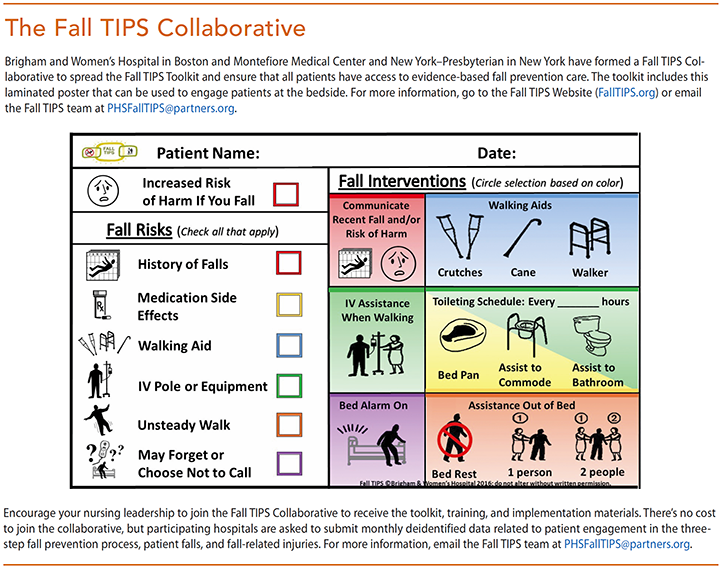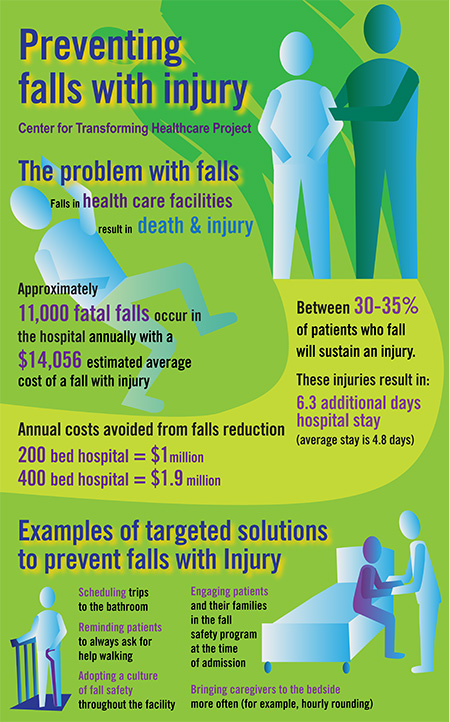
Falls in hospital There are many reasons you may be at risk of falling in hospital. Fall prevention involves managing a patients underlying fall risk factors and optimizing the hospitals physical design and environment.

This may include equipment that reduces the risk of an injury such as hip protectors and rails on the sides of your bed.
Prevent falls in hospitals. Research shows that close to one-third of falls can be prevented. Fall prevention involves managing a patients underlying fall risk factors and optimizing the hospitals physical design and environment. This toolkit focuses on overcoming the challenges associated with developing implementing and sustaining a fall prevention program.
Yet falls are not true accidents and there is evidence that a coordinated multidisciplinary clinical team approach can reduce their incidence. Identification of multiple underlying risk factors coupled with clear interventions to ameliorate the impact of each has been shown to reduce the incidence of inpatient falls. Falls among hospital inpatients are the most frequently reported safety incident in hospital.
Not all falls are preventable but neither are they inevitable. 2030 of falls can be prevented by assessing risks and intervening to reduce these risks. The available fall risk screening tools are too insensitive to be helpful in preventing inpatient falls.
Falls in hospitalized patients are a pressing patient safety concern but there is a limited body of evidence demonstrating the effectiveness of commonly used fall prevention interventions in hospitals. This article reviews common study designs and the evidence for various hospital fall prevention interventions. Some chairs can be adjusted.
Talk to hospital staff about other ways you can prevent falls and injuries from falls. This may include equipment that reduces the risk of an injury such as hip protectors and rails on the sides of your bed. If you do fall keep calm and call for help.
Reducing Your Risk of Falls in the Hospital Ways that you can reduce the risk of falling during a hospital stay include staying in bed or staying seated. Caregivers can make sure that you have easy access to things you need like the care light the phone and water. STEADI Improves Patient Outcomes Using CDCs STEADI program to prevent older adult falls in a hospital-based setting improved the quality of life for many patients.
Data collected from the falls prevention program at the Rees-Jones Trauma Center showed a statistically-significant decreased length of stay in the hospital. Patient education is another important part of reducing patient falls both in the hospital and once patients return home. Educate patients on why they are at risk for falls and how they can reduce their chance of falls and injuries.
Patient falls continue to be a top adverse event in hospital settings often resulting in injury and even death. Although fall risk is more common among elderly and frail patients any patient can be at risk for a fall due to physiological changes related to medications surgery procedures diagnostic tests or a medical condition among other factors. Educate hospital leadership and Implementation Team on the Preventing Falls in Hospitals Toolkit to facilitate the change process in hospitals.
Develop hospital-specific action plans for implementing a Fall Prevention Program using the Toolkit. Address specific challenges of preventing falls in your hospital. A combination of strategies is needed to help prevent falls in hospitals.
Strategies may focus on the environment the level of care the use of equipment and aids. All strategies should consider the individual patients health and personal needs. Ways to prevent falls in hospital.
Falls in hospital There are many reasons you may be at risk of falling in hospital. Being un well and in an unfamiliar place Poor mobility and balance unsafe when walk ing Badl y fitting footwear and clothing Poor eyesight.